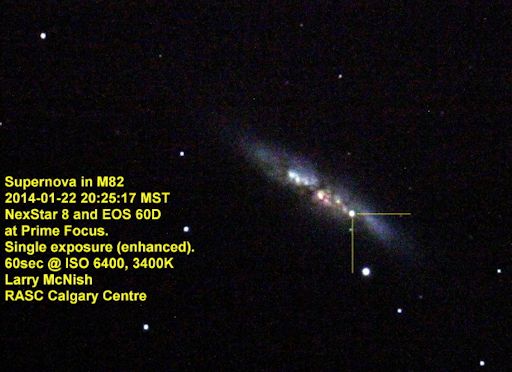MOSTLY QUIET WITH A CHANCE OF FLARES: With no sunspots actively flaring, solar activity is low. However, sunspots AR1957 and AR1959 could break the quiet. Both regions have 'beta-gamma' magnetic fields that harbor energy for medium-sized eruptions. NOAA forecasters estimate a 15% chance of M-class flares on Jan. 24th. Solar flare alerts: text, voice
NO CME, NO PROBLEM: A CME expected by forecasters to deliver a glancing blow to Earth's magnetic field on Jan. 23rd missed our planet. Arctic sky watchers got an eye-full anyway. Dennis Ball sends this picture of colors erupting last night over Bolungarvik, Iceland:
"After a day of horrid weather, the clouds parted at 9 PM and I grabbed by camera to photograph the auroras," says Ball. "By 10.30 PM the clouds had rolled in again, so I got an early night. It was an excellent start to my Iceland trip."
The source of the display was not a CME, but rather a fluctuation in the interplanetary magnetic field or "IMF." On Jan. 23rd, the IMF tilted south for a few hours, opening a crack in Earth's magnetosphere. Solar wind poured in to fuel the auroras.
SUPERNOVA! Approximately 12 million years ago, a white dwarf star in the galaxy M82 exploded. This week, light from the distant supernova finally reached Earth. Amateur astronomers can see it through backyard telescopes as a fireball of magnitude +11.2 in one of the galaxy's dusty spiral arms. Here is the view through an 8-inch telescope on Jan. 22nd:
Larry McNish took the picture from the University of Calgary's Rothney Astrophysical Observatory in Alberta, Canada. "I used a Canon 60D DSLR at the prime focus of an 8 inch Celestron SCT telescope," he says. "This is just a single exposure of 60 seconds at ISO 6400 using a white balance of 3400K to reduce the sodium sky glow from Calgary."
Although it is 12 million light years away, M82 is considered to be a next-door neighbor of the Milky Way. Indeed, this is the nearest supernova to Earth since SN 1993J was famously observed 21 years ago. The relative proximity of the blast makes it an attractive target for astronomers to study. Light curves from previous supernovas of this type suggest that the fireball could continue to brighten for the next two weeks.
If you have a GOTO telescope, this evening command it to slew to the "cigar galaxy" or "M82," and watch the explosion unfold.

Solar wind
speed: 367.2 km/sec
density: 2.1 protons/cm3
explanation | more data
Updated: Today at 1646 UT
X-ray Solar Flares
6-hr max: B9 1037 UT Jan24
24-hr: B9 1037 UT Jan24
explanation | more data
Updated: Today at: 1600 UT
![]()
Daily Sun: 24 Jan 14
Sunspots AR1957 and AR1959 have 'beta-gamma' magnetic fields that harbor energy for M-class solar flares. Credit: SDO/HMI
![]()
Sunspot number: 121
What is the sunspot number?
Updated 24 Jan 2014
Spotless Days
Current Stretch: 0 days
2014 total: 0 days (0%)
2013 total: 0 days (0%)
2012 total: 0 days (0%)
2011 total: 2 days (<1%)
2010 total: 51 days (14%)
2009 total: 260 days (71%)
Update 24 Jan 2014
The Radio Sun
10.7 cm flux: 136 sfu
explanation | more data
Updated 24 Jan 2014
![]()
Current Auroral Oval:
Switch to: Europe, USA, New Zealand, Antarctica
Credit: NOAA/POES
![]()
Planetary K-index
Now: Kp= 1 quiet
24-hr max: Kp= 3 quiet
explanation | more data
Interplanetary Mag. Field
Btotal: 6.3 nT
Bz: 2.0 nT north
explanation | more data
Updated: Today at 1646 UT
![]()
Coronal Holes: 24 Jan 14
There are no large coronal holes on the Earthside of the sun. Credit: SDO/AIA.






